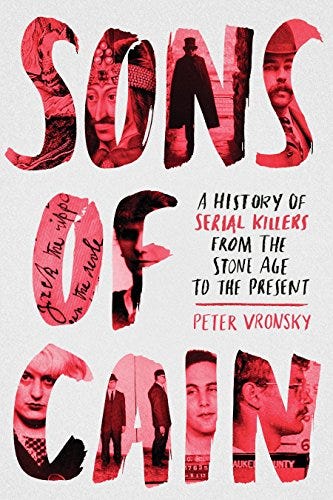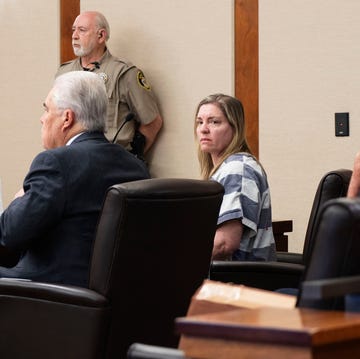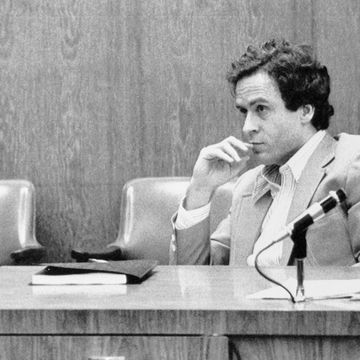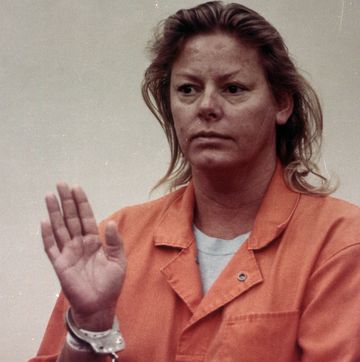America saw a spate of headline-capturing serial killers beginning in the 1970s. The captures of Edmund Kemper and the Son of Sam early in the decade were followed by the falls of Ted Bundy, John Wayne Gacy, and the Night Stalker by the time the 1980s were coming to a close. But by the ’90s, you were more likely to find a mass murderer at the cinema than on the evening news.
As the FBI notes, “There is no single identifiable cause or factor that leads to the development of a serial killer.” But that hasn’t stopped sociologists, criminologists, and true crime junkies of all stripes from speculating why the 1970s seemed to have so many serial killers compared to the decades before and after.
Who qualifies as a serial killer?
Before digging into why serial killers had free reign in the ’70s, it’s important to understand who exactly they are. Defining what makes a serial killer is a more nuanced conversation than you might think. It was part of the conversation at a 2005 FBI symposium on serial murder precisely because multiple definitions exist and vary in manners “such as the number of murders involved, the types of motivation, and the temporal aspects of the murders.”
The definition the symposium ultimately settled on was “The unlawful killing of two or more victims by the same offender(s), in separate events.” That might seem fairly broad, but that’s because it needs to be. As the symposium established, “There is no generic profile of a serial murderer.”
There are, of course, commonalities that connect a large swath of serial killers. The symposium outlined that some serial murderers share personality traits such as “sensation seeking, a lack of remorse or guilt, impulsivity, the need for control, and predatory behavior.”
Experts have also noted the majority of serial killers are male, pointing to data that just 5 to 11 percent of known murderers are women. The question of why there’s such a gendered disparity has no agreed upon answer.
Conditions in post-war America could be to blame for the rise of serial killers
One possible explanation for the (mostly) men who grew up to become America’s most infamous serial killers might be the men who came home from fighting in Europe to raise them (and those who didn’t come home at all). Investigative historian Peter Vronsky posits in his book Sons of Cain: A History of Serial Killers from the Stone Age to the Present that the glut of psychologically damaged men who killed innocent citizens could have been impacted by their fathers being psychologically damaged by the killing they had to do during World War II.
During that global conflict, soldiers witnessed new and horrific forms of carnage and cruelty. The post-war America of the 1950s, when these men would have been acting as parents, didn’t offer them many outlets to properly grapple with the mental toll these horror took on them. Whether through abuse, neglect, or misguided attempts at “making their son a man,” these WWII veterans passed residual trauma onto their children, which might have twisted them into killers.
Environmental factors could also be to blame. It might seem outlandish, but it’s entirely possible that the switch to unleaded gasoline (which began in the 1970s and was completed in 1996) could have had a massive impact on the reduction of not just murders but all crimes within the United States. Crime of virtually all kinds statistically decreased starting in the 1990s, and proponents of what is called the “lead-crime hypothesis” note that this correlates with the removal of lead from things like gasoline and paint.
Many studies suggest lead exposure can have negative impacts on a child’s developing brain, and the lead-crime theory posits that the problems children acquired from this exposure turned some into serial killers. It’s tricky to confirm, given other environmental factors like poverty coinciding with many incidents of lead exposure. However, a recent paper from Jennifer Doleac, an expert in the economics of crime, pulls together a number of studies which have attempted to hone in on the lead-crime hypothesis. Her comprehensive analysis makes the case stronger.
A hot-button hypothesis from scholars Steven Levitt and John Donohue, made popular by the best-selling book Freakonomics, instead connects the reduction in crime in the 1990s with the expansion of abortion access in the United States in the aftermath of Roe v. Wade (1973). It posits that the reduction in “unwanted children” (meaning kids born to parents who didn’t plan for or want a child) reduced the number of children raised in situations that could influence their future criminal behavior.
This association caused controversy, as it seemed to some readers to echo the idea of eugenics posited at the turn of the American century by figures like birth control activist Margaret Sanger. In 2019, Levitt and Donohue revisited the study on NPR’s Freakonomics Radio. While distancing themselves from the eugenics implications, they reaffirmed their conclusions on their abortion theory by bringing updated data to their study.
Societal changes might have increased violent urges and opportunity
Although not tied directly to the 1970s nor serial killers, criminologist Robert Agnew’s general strain theory identifies what causes crime in the first place. He posits: “strains or stressors increase the likelihood of negative emotions like anger and frustration. These emotions create pressure for corrective action, and crime is one possible response.” Strains can be economic or social, such as “relationships in which others are not treating the individual as he or she would like to be treated.” In either case, the strain represents a loss of control and a drive to “survive” amidst tumult.
The 1970s were a time of great social upheaval on racial and gender grounds. Paired with a recession and inflation that led President Gerald Ford to say “The State of the Union is not good,” you have a recipe for the disaffected who lack the societal status they are supposedly owed to lash out.
The societal shifts of the 1970s might have contributed to the rise of serial killers in a different way. In 1979, criminologists Lawrence E. Cohen and Marcus Felson proposed the “routine activity approach” that suggests simple structural changes in society’s routine activities “can influence crime rates by affecting the convergence in space and time of the three minimal elements of direct-contact predatory violations: (1) motivated offenders, (2) suitable targets, and (3) the absence of capable guardians against a violation.”
To put the approach in more concrete terms, consider this example from Cohen and Felson: As more women enter the labor force and college, there is a greater market for automobiles and, therefore, more opportunities for grand theft auto. Extrapolating this framework further, the criminologists suggest that as more women and younger adults were taking more opportunities outside the home, it created more opportunities for them to be victims of violent crime given that society’s older routines hadn’t yet adjusted to better defend against new threats.
We can see evidence of this in a serial killer from a different era: H.H. Holmes. Inside his infamous Chicago murder house, he preyed upon young unmarried women who had come to the “white city” to pursue financial independence in ways never before offered to them.
As Northeastern Global News paraphrased a comment from criminologist James Alan Fox: “With widespread social and cultural changes in the 60s and 70s—drug use, hitchhiking, the hippie movement, anti-establishment sentiment—conditions were prime for predators to go on the prowl.”
Technological gaps allowed serial killers to go unnoticed
Investigative conditions also favored the array of serial killers in the 1970s and ’80s. “The offenders certainly had a head start,” criminologist Michael Arntfield told the BBC, suggesting that the police at the time “were out of their depth.” He notes that prior to the early 1980s, law enforcement simply wasn’t compiling data in a way to even identify the patterns of a serial killing.
Take, for example, the case of Rodney Alcala, who was convicted in 1980 of seven murders but was possibly responsible for many more. In 1978, Alcala applied to appear on the popular television program The Dating Game despite his criminal record that included being a registered sex offender. As Biography has previously reported, “There was no national crime database, and the technology needed for complete background checks on contestants didn’t exist.” Because of this, Alcala actually made it all the way onto the show.
It’s possible the seemingly sudden burst of serial killers in the 1970s was more because the police and the media had suddenly started to take notice. Who knows how many unsolved murders of previous decades were at the hands of a single serial killer, but no one ever noticed the pattern?
The ability to recognize those patterns now, and even create profiles of possible killers (as popularized by the Netflix show Mindhunter), could also have contributed to why America saw far fewer prolific serial killers in the final years of the 20th century. The theory goes that we simply got better at catching killers early on.
To this end, what began in 1972 as the FBI’s fledgling Behavioral Science Unit grew in the decades since, with the 1985 formations of the National Center for the Analysis of Violent Crime at the FBI Academy and the Violent Criminal Apprehension Program, as well as the 1996 creation of the Child Abduction and Serial Killer Unit. These programs and others like them not only provide crime analysis data and products to other law enforcement agencies, but also serve to “link seemingly unrelated crime investigations and share investigative data from violent crimes across the country.” This could explain why serial killers aren’t as prolific as they once were; law enforcement has purportedly gotten much better at identifying potential serial killings and collaborating to stop them.
Modern technology has also played a role, given that everyone leaves behind a greater digital footprint than they realize. Consider how the BTK Killer was ultimately undone in 2005 by a floppy disk, or how the Golden State Killer was finally caught in 2018 after a family member had done an online DNA genealogy analysis. Our loss of anonymity in the digital age, in theory, makes it far harder for serial killers to operate unnoticed.
Whether “constant digital surveillance keeps serial killers at bay” is a comforting thought is debatable (since constant digital surveillance in and of itself presents problems), but it’s more comforting than the final major theory: that the decline in known serial killers from the 1970s isn’t because we’ve gotten better at catching killers but actually because we’ve gotten far worse.
The Murder Accountability Project offers a chart which depicts the homicide clearance rates, meaning the number of murders solved, in the United States from 1965 to 2023. In 1965, the clearance rate was 91 percent, leaving only 9 percent of murders unsolved. Jump ahead to 1983, and while the estimated homicides total had more than doubled from that of 1965, the clearance percentage decreased to 76 percent.
Jump ahead again to the most recent data from 2023, and the statistics look more troubling. The nonprofit tallied roughly 1,000 fewer estimated homicides compared to 40 years ago yet the clearance rate was down to just 57.8 percent. Worse yet, that stat is actually an improvement on 2022, which hit an all-time low for clearance rate, at 52.3 percent.
In other words, it’s possible that the reason we aren’t seeing as many serial killers in the newspapers as we did in the 1970s isn’t because there aren’t as many out there; it’s simply that we just don’t see them.
Michale Natale is a News Editor for the Hearst Enthusiast Group. As a writer and researcher, he has produced written and audio-visual content for more than fifteen years, spanning historical periods from the dawn of early man to the Golden Age of Hollywood. His stories for the Enthusiast Group have involved coordinating with organizations like the National Parks Service and the Secret Service, and travelling to notable historical sites and archaeological digs, from excavations of America’ earliest colonies to the former homes of Edgar Allan Poe.

















